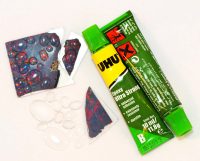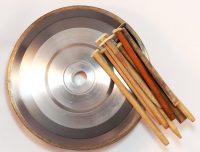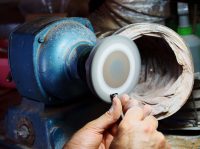When cutting opal with a diamond saw blade it is important to have sufficient water running on your blade or to have your blade running in water. Without sufficient water you risk shortening the life of your blade if not destroying it altogether. Also, too little water will generate too much heat which will crack your opal. I advise safety glasses be worn during cutting. It’s not very nice getting a fine slither of opal in your eye.
Don’t be afraid of the blade. If you don’t cut with confidence you risk damaging the blade if the stone turns in your hands and you risk breaking your opal if it slips through your fingers.
Always hold the opal to be cut with both hands. With the opal in your fingers bring it into contact with the blade. Apply enough pressure to start cutting. You don’t need to force the opal through the blade. Let the blade do the cutting. As the blade cuts maintain a constant pressure until the cut is finished. Just remember you can only make a straight cut.
If you are using a box saw or one with a tank be careful the stone doesn’t turn on the table. If the stone turns on the table the blade will be damaged.
If you are using a free hand saw or over head saw, bring your opal into contact with bottom of the blade. You will have more control.
Avoid cutting opals that are too large for the blade. Cutting opals that are too large for the blade will over heat the blade causing it to lose centre tension which will cause the blade to buckle.
There are many types of diamond saw blades and some of them respond well to sharpening. I advise sharpening your blade every day before you start cutting. If you are cutting for several hours, sharpen the blade every 15-20 minutes. This will ensure cleaner cuts, faster cuts and less damage to your blade and opal. If you wait too long before you sharpen your blade, it may be too late.
To sharpen your blade, make several cuts through some sandstone or other soft abrasive material. I use and recommend a block of aluminium oxide for sharpening saw blades, approximately #220 grit.
Don’t leave your blade sitting in water it will rust away. If water flows onto your blade like a brick saw make sure you turn the water off after use. Water that gathers on the bottom of a blade causes corrosion, a weakness. When you start to cut next time the first part of your blade to wear is the weakest part, where the corrosion is. Before you know it your blade is running out of round and wearing unevenly.
Make sure the blade fits correctly on the shaft. If you have to force the blade onto the shaft, you will have trouble getting the blade off when it is time to change it. When changing the blade, put a little oil on the shaft so the blade will slide on easier and it should come off the same way when it is time to change it.
The machine I use is a Gemmasta GFHS2 Freehand Opal Saw. It is like a smaller version of an overhead brick saw. You can use 6” or smaller blades on it. The blade turns at 4200 rpm.




